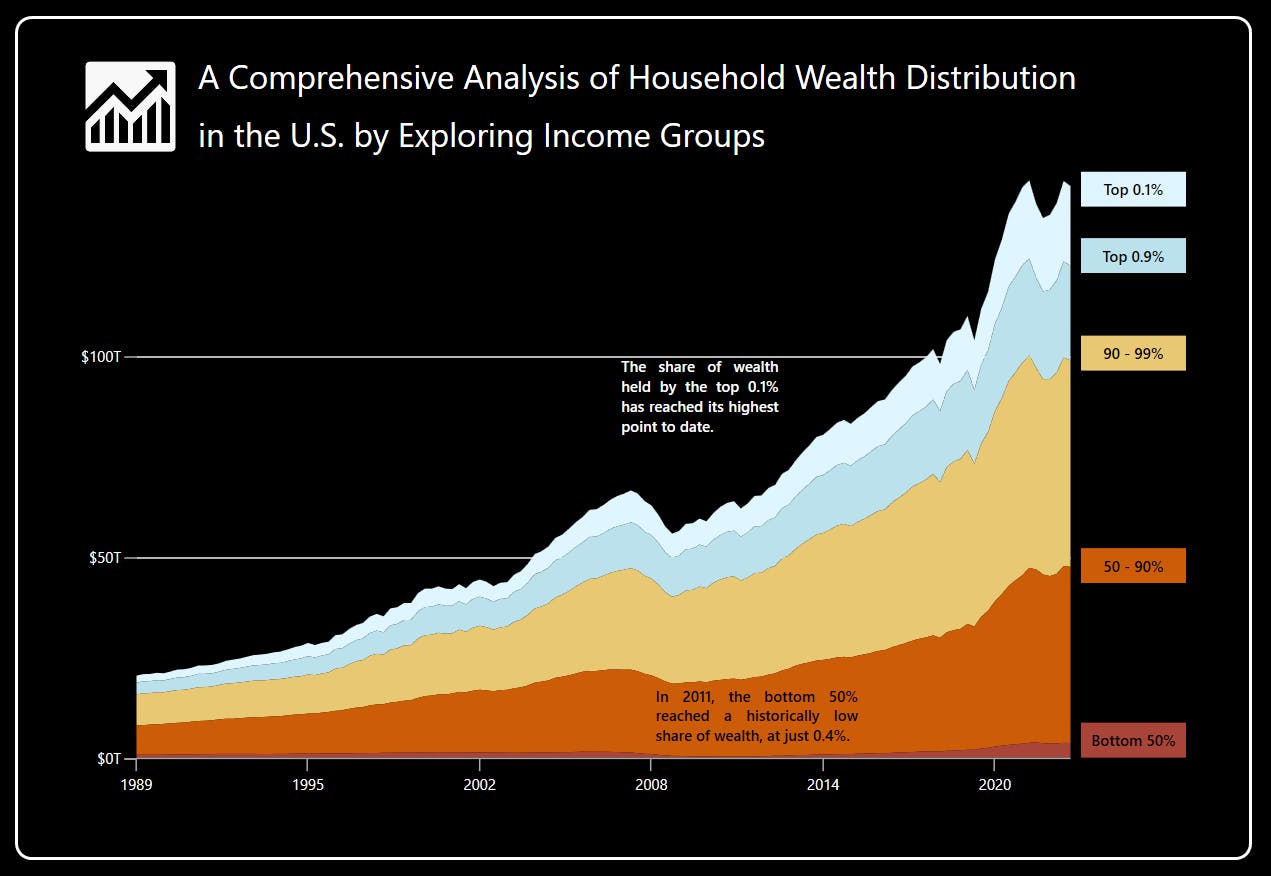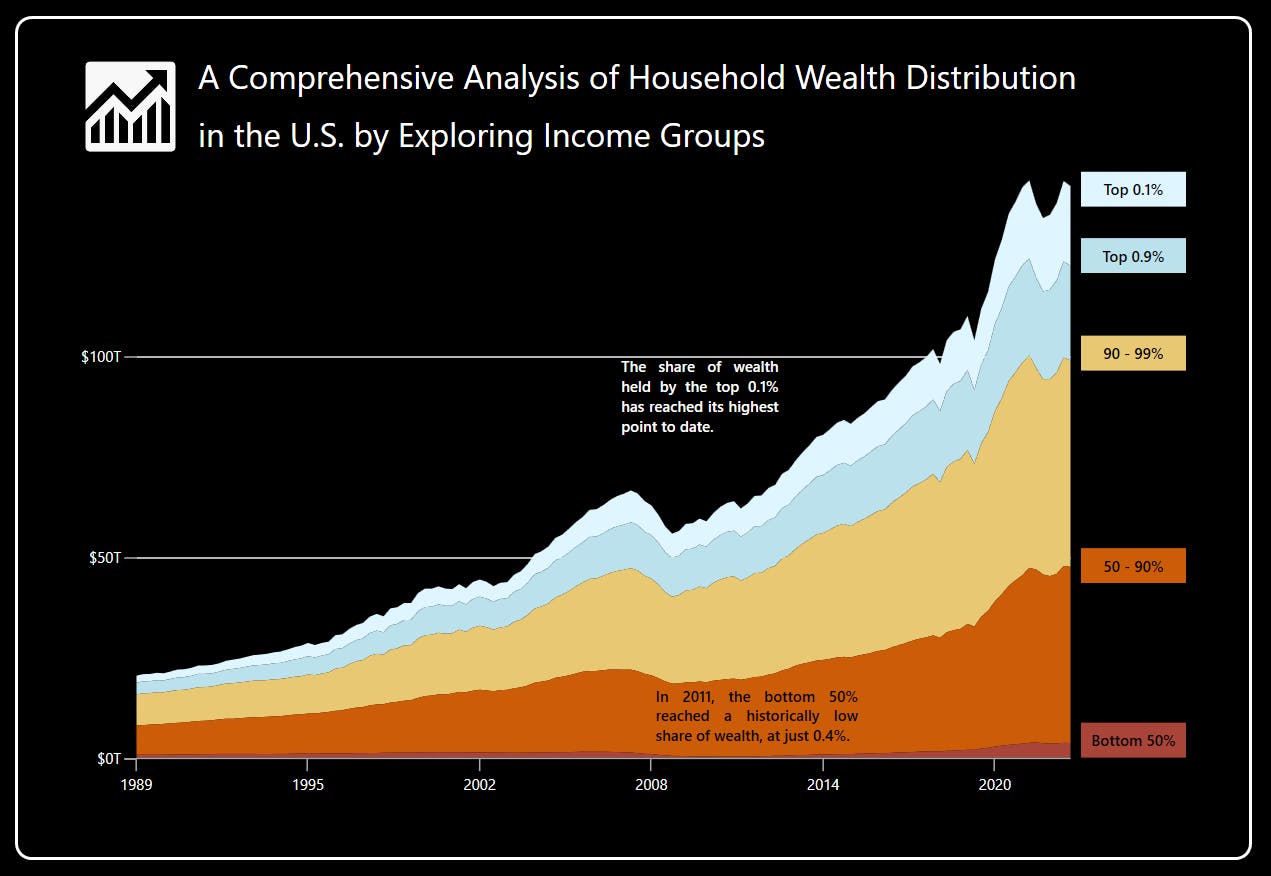Chart of the Week: Creating a WPF Stacked Area Chart to Visualize Wealth Distribution in the U.S.
TL;DR: Learn to visualize wealth distribution in the U.S. from 1990 to 2023 using Syncfusion WPF Stacked Area Chart. Explore a step-by-step guide on data preparation, chart layout design, customization, and more. Dive into insightful analysis with this powerful tool!
Welcome to our Chart of the Week blog series!
Today, we will visualize the U.S. wealth distribution data based on income groups using the Syncfusion WPF Stacked Area Chart.
The [WPF Stacked Area Chart](help.syncfusion.com/wpf/charts/seriestypes/.. "Getting started with WPF Stacked Area Chart") is a data visualization tool used to represent the cumulative values of different categories over time. It comprises multiple data series stacked on each other, with the area below the lines filled with colors to differentiate between the categories.
The following image shows the chart we’re going to create.
Let’s get started!
Step 1: Gathering the data
Before creating the chart, we should collect the data from [the wealth distribution report](federalreserve.gov/releases/z1/dataviz/dfa/.. "Report Article: Distributional Financial Accounts"). We can also download the data in CSV format.
Step 2: Prepare the data for the chart
Let’s design the WealthData class with the Date and Value properties to encapsulate the details of wealth distribution.
Refer to the following code example.
public class WealthData { public string Date { get; set; } public double Value { get; set; } public WealthData(string date, double value) { Date = date; Value = value; } }
Now, design the LabelItem class with the Content and Position properties to encapsulate the details of custom axis labels.
Refer to the following code example.
public class LabelItem { public string? Content { get; set; } public double Position { get; set; } }
Then, configure the HouseHoldWealthData class to organize the assortment of data regarding wealth distribution across income groups over different periods. Subsequently, this data will be stored in an observable collection utilizing the different properties based on income groups.
Refer to the following code example.
public class HouseHoldWealthData { public ObservableCollection Bottom50Data { get; set; } public ObservableCollection Next40 { get; set; } public ObservableCollection Top9 { get; set; } public ObservableCollection Top1 { get; set; } public ObservableCollection TopPoint1 { get; set; }
public List Labels { get; set; }
public HouseHoldWealthData() { Bottom50Data = new ObservableCollection(); Next40 = new ObservableCollection(); Top9 = new ObservableCollection(); Top1 = new ObservableCollection(); TopPoint1 = new ObservableCollection(); Labels = new List();
ReadCSV(); } }
Then, the CSV data will be converted to a data collection using the ReadCSV method. Each collection’s maximum values will be collected to update the custom label position.
Refer to the following code example.
public void ReadCSV() { Assembly executingAssembly = typeof(App).GetTypeInfo().Assembly; Stream inputStream = executingAssembly.GetManifestResourceStream("WhealthDistributionSample.dfanetworthlevels.csv"); List lines = new List(); if (inputStream != null) { string line; StreamReader reader = new StreamReader(inputStream); while ((line = reader.ReadLine()) != null) { lines.Add(line); } lines.RemoveAt(0);
double _bottom50 = 0, _next40 = 0, _top9 = 0, _top1 = 0, _topPoint1 = 0;
foreach (var dataPoint in lines) { string[] data = dataPoint.Split(','); string[] date = data[0].Split(':');
switch (data[1]) { case "Bottom50": var bottom50value = Convert.ToDouble(data[2]); Bottom50Data.Add(new WealthData(date[0], bottom50value)); _bottom50 = Math.Max(bottom50value, _bottom50); break; case "Next40": var next40Value = Convert.ToDouble(data[2]); Next40.Add(new WealthData(date[0], next40Value)); _next40 = Math.Max(next40Value, _next40); break; case "Next9": var next9Value = Convert.ToDouble(data[2]); Top9.Add(new WealthData(date[0], next9Value)); _top9 = Math.Max(next9Value, _top9); break; case "RemainingTop1": var remainingTop1Value = Convert.ToDouble(data[2]); Top1.Add(new WealthData(date[0], remainingTop1Value)); _top1 = Math.Max(remainingTop1Value, _top1); break; default: var topPoint1Value = Convert.ToDouble(data[2]); TopPoint1.Add(new WealthData(date[0], topPoint1Value)); _topPoint1 = Math.Max(topPoint1Value, _topPoint1); break; }
} AddCustomLabels(_bottom50, _next40, _top9, _top1, _topPoint1);
} }
Let’s add the custom labels and position them using the Content and Position properties, respectively, in the Labels collection. Here, we will position the custom labels for each series at their maximum value data point.
Refer to the following code example.
private void AddCustomLabels(double bottom50, double next40, double top9, double top1, double topPoint1) { next40 += bottom50; top9 += next40; top1 += top9; topPoint1 += top1;
Labels.Add(new LabelItem() { Position = bottom50, Content = "Bottom 50%" }); Labels.Add(new LabelItem() { Position = next40, Content = "50 - 90%" }); Labels.Add(new LabelItem() { Position = top9, Content = "90 - 99%" }); Labels.Add(new LabelItem() { Position = top1, Content = "Top 0.9%" }); Labels.Add(new LabelItem() { Position = topPoint1, Content = "Top 0.1%" }); }
Step 3: Adding a border to the chart
Before creating the chart, let’s add a border. This helps us organize and visualize the data efficiently.
Refer to the following code example.
<!—Set border for the chart--> <!—Create the chart inside the border-->Step 4: Configure the Syncfusion WPF Charts control
Now, configure the Syncfusion [WPF Charts](syncfusion.com/wpf-controls/charts "WPF Charts control") control utilizing this [documentation](help.syncfusion.com/wpf/charts/getting-star.. "Getting started with WPF Charts").
Refer to the following code example.
Step 5: Bind the data to the WPF Stacked Area Chart
We will utilize the Syncfusion WPF [StackingAreaSeries](help.syncfusion.com/cr/wpf/Syncfusion.UI.Xa.. "StackingAreaSeries class of WPF Charts") to visualize the wealth distribution data. Ensure that the HouseHoldWealthData class is configured to establish a binding between its properties and the Chart’s DataContext.
Refer to the following code example.
In the above code example, each series’ **XBindingPath** and **YBindingPath** properties are bound with the respective series’ **Date** and **Value** properties, respectively. Step 6: Create the duplicate axis to customize the chart -------------------------------------------------------- Let’s showcase the income group details in each series for better visualization. To achieve this, we will use the duplicate Y-axis to display custom labels. First, we will create the [NumericalAxis](help.syncfusion.com/wpf/charts/axis#numeric.. "NumericalAxis class of WPF Stacked Area Chart") (Y-axis positioned at the left) in the chart’s **Resources** property and assign the axis to each series’ [YAxis](help.syncfusion.com/cr/wpf/Syncfusion.UI.Xa.. "YAxis property of WPF Stacked Area Chart") property. This will act as the major Y-axis for the chart’s series. Then, we will create a secondary Y-axis as a duplicate one (Positioned at the right) to showcase the custom labels. Next, bind the **Labels** collection to the [LabelsSource](help.syncfusion.com/cr/wpf/Syncfusion.UI.Xa.. "LabelsSource property of WPF Stacked Area Chart") property and set the [PositionPath](help.syncfusion.com/cr/wpf/Syncfusion.UI.Xa.. "PositionPath property of WPF Stacked Area Chart") and [ContentPath](help.syncfusion.com/cr/wpf/Syncfusion.UI.Xa.. "ContentPath property of WPF Stacked Area Chart") properties. Refer to the following code example. . . .
<!—using a color converter for returning the border background color based on the label content -->
The custom labels will be positioned based on the axis values (EX: 50- 90%). To achieve this, we will add the values for the Maximum and Minimum properties of the duplicate axis based on the major YAxis’ ActualMaximum and ActualMinimum values.
private void NumericalAxis_ActualRangeChanged(object sender, ActualRangeChangedEventArgs e) { customAxis.Maximum = (double?)e.ActualMaximum; customAxis.Minimum = (double?)e.ActualMinimum; }
Step 7: Customize the chart appearance
Let’s customize the [appearance](help.syncfusion.com/wpf/charts/appearance "Customizing the appearance of WPF Charts") of the Syncfusion WPF Stacked Area Chart to enhance its readability.
Customize the chart header
Refer to the following example to customize the chart [header](help.syncfusion.com/cr/wpf/Syncfusion.UI.Xa.. "Header property of WPF Stacked Area Chart").
. . .
. . .
Customize the axis
Refer to the following code example. Here, we are going to customize the Y-axis in the chart.
<charts:NumericalAxis Interval="50000000"
LabelCreated="NumericalAxis_LabelCreated"
Maximum="146000000” >
Let’s modify the content of the axis labels using the LabelCreated event.
private void NumericalAxis_LabelCreated(object sender, LabelCreatedEventArgs e) { double value = Convert.ToDouble(e.AxisLabel.LabelContent); double trillionValue = value / 1000000; if(trillionValue <= 100) { e.AxisLabel.LabelContent = $"${trillionValue}T"; } else { e.AxisLabel.LabelContent = string.Empty; e.AxisLabel.Position = 0; } }
Then, customize the X-axis by referring to the following code example.
Customize the chart series
Now, customize each stacked area series’ color using the [Interior](help.syncfusion.com/cr/wpf/Syncfusion.UI.Xa.. "Interior property of WPF Stacked Area Chart") property.
.. .
. . .
Adding annotations to the chart
Next, we’ll enhance the chart’s readability with the [Text Annotation](help.syncfusion.com/wpf/charts/annotations#.. "Text annotation in WPF Stacked Area Chart") to provide contextual insights.
After executing these code examples, we will get the output that resembles the following image.

Visualizing the U.S. wealth distribution data using Syncfusion WPF Stacked Area Chart
GitHub reference
For more details, refer to [visualizing the U.S. wealth distribution data using the WPF Stacked Area Chart GitHub demo](github.com/SyncfusionExamples/Creating-the-.. "WPF Stacked Area Chart to visualize wealth distribution in the U.S. GitHub demo").
Conclusion
Thanks for reading! In this blog, we’ve seen how to visualize data on wealth distribution in the U.S. based on income groups using the Syncfusion [WPF Stacked Area Chart](help.syncfusion.com/wpf/charts/seriestypes/.. "WPF Stacked Area Chart"). We strongly encourage you to follow the steps outlined in this blog and share your thoughts in the comments below.
The existing customers can download the new version of Essential Studio on the [License and Downloads](syncfusion.com/account "Essential Studio License and Downloads page") page. If you are not a Syncfusion customer, try our 30-day [free trial](syncfusion.com/downloads "Get free evaluation of the Essential Studio products") to check out our incredible features.
You can also contact us through our [support forums](syncfusion.com/forums "Syncfusion Support Forums"), [support portal](support.syncfusion.com "Syncfusion Support Portal"), or [feedback portal](syncfusion.com/feedback "Syncfusion Feedback Portal"). We are always happy to assist you!
Related blogs
- [Chart of the Week: Creating a WPF 3D Column Chart to Visualize the Panama Canal’s Shipment Transit Data](syncfusion.com/blogs/post/wpf-3d-column-cha.. "Blog: Chart of the Week: Creating a WPF 3D Column Chart to Visualize the Panama Canal’s Shipment Transit Data")
- [Chart of the Week: Creating a WPF Chart Dashboard to Visualize the 2023 World Billionaires list](syncfusion.com/blogs/post/wpf-chart-world-b.. "Blog: Chart of the Week: Creating a WPF Chart Dashboard to Visualize the 2023 World Billionaires list")
- [Harmonizing Powerhouses: Syncfusion WPF Controls Are Now Compatible with Avalonia XPF](syncfusion.com/blogs/post/wpf-ui-compatible.. "Blog: Harmonizing Powerhouses: Syncfusion WPF Controls Are Now Compatible with Avalonia XPF")
- [Chart of the Week: Creating a WPF Bar Chart to Visualize the Homelands of America’s International Students](syncfusion.com/blogs/post/wpf-bar-chart-us-.. "Blog: Chart of the Week: Creating a WPF Bar Chart to Visualize the Homelands of America’s International Students")


